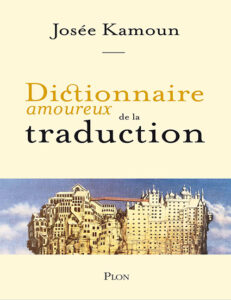Literary translation : Dictionnaire amoureux de la traduction (A Lover’s Dictionary of Translation)

Josée Kamoun’s Dictionnaire amoureux de la traduction (A Lover’s Dictionary of Translation) is at once a literary journey, a translator’s notebook, and a heartfelt tribute to a profession that thrives in the spaces between languages. Renowned for her brilliant literary translations of authors such as Philip Roth, John Irving, William Faulkner, and Virginia Woolf, Kamoun invites readers into her intellectual, sensitive, and passionate world.
The book takes the characteristic form of the “Dictionnaire amoureux” collection: a series of entries arranged in alphabetical order, each dedicated to a word, concept, work, or author closely or remotely related to translation. But in Kamoun’s work, this structure becomes a pretext for a stroll, where anecdotes mingle with reflections, portraits of writers with translators’ confessions, and precise analyses with cultural digressions.
Literary Translation in Flesh and Spirit
Kamoun does not simply define concepts. She brings them to life through her personal experience and her sensitivity as a professional translator. Translating, she writes, is “living in two languages at once,” standing in a shifting space where one listens, compares, adjusts, and recreates. It is neither a simple mechanical transfer of words nor a school exercise in correspondence: it is a practice that intertwines grammatical rigor, poetic intuition, and a deep cultural awareness.
She explains, for example, how each project involves a ritual: rereading the original text in its entirety, allowing an “inner ear” for the author’s voice to develop, then diving into the work, sentence by sentence, searching for the right tone. Far from a simple technical operation, this process is for her an intimate partnership with the writer.
From Shakespeare to Scheherazade
Some entries are veritable literary short stories. In the article devoted to Hamlet, Kamoun looks back at the many translations of the play, the dilemmas posed by famous lines—such as “To be or not to be”—and how each translator leaves their mark. In the article on One Thousand and One Nights, she explores the versions by Antoine Galland and Richard Burton, revealing how each era and each translator shapes the perception of a text.
These pages are filled with concrete examples, sometimes word-for-word comparisons, which illustrate how a choice of words or rhythm can transform the tone of a sentence or even the overall meaning and quality of a work.
Challenges Every Translator Faces
Kamoun devotes several entries to recurring issues in the profession:
- The question of tu and vous, and their lack of direct equivalents in English.
- Managing connotations and denotations, where a French word never exactly matches the semantic field of its English equivalent.
- The importance of rhythm and musicality, which are often invisible to the reader but fundamental to the coherence of the work.
It also addresses the subject of translator’s notes, explaining how they can shed light on a context or an untranslatable pun, but also break the narrative thread if they are too intrusive.
Literary Translation in the Era of AI
One of the most contemporary entries is devoted to AI and machine translation. Kamoun analyzes the strengths and, above all, the limitations of these tools: speed and usefulness for simple tasks, but an inability to convey cultural nuances, irony, tone, or an author’s unique voice. She warns against the temptation to reduce translation to mere data processing and reaffirms that translation remains a creative act, rooted in the human experience.
AI, she says, “calculates the probability of words” but knows nothing about the narrative flow, stylistic coherence, and cultural implications that structure a work. It does not understand the underlying irony of a sentence, does not perceive the polyphony of a text in which several voices overlap, and cannot grasp the emotional charge of a word chosen by the author for its rarity or musicality.
Post-editing, on the other hand, is an exercise that Kamoun compares to delicate surgery: it involves taking a raw translation generated by a machine and reshaping it to make it fluid, accurate, and lively. But she warns that when the source text is heavily flawed in terms of rhythm or semantics, post-editing can take as much time and effort as a full translation by a human translator. The productivity gains touted by some market players therefore prove illusory, to the detriment of quality. Kamoun defends a vision in which AI can have its place as a support tool for certain stages of the work (lexical pre-analysis, identification of recurrences, terminology assistance), but she insists that the real added value of the professional translator lies in their ability to interpret, adapt, and reinvent a text in another language, taking into account cultural subtleties and writing choices.
Who is this book intended for?
- This book is aimed at several audiences:
- professional translators, who will find the challenges, joys, and dilemmas of the profession reflected in its pages.
- Students and apprentice translators, for whom it will serve as a lively manual for reflection and inspiration.
- Literature lovers who want to discover what goes on behind the scenes and understand how a text is transferred from one language to another without losing its soul.
A lively, open-handed prose style
- What strikes the reader is the warmth and authenticity of the writing. Kamoun does not seek to “teach” in the strict sense of the word, but rather to share experiences, insights, and memories. She quotes passages from authors she has translated, analyzes her own choices, sometimes her mistakes, and is not afraid to take a stand. The result is a sincere portrait of the translation profession: demanding, discreet, but essential to the circulation of ideas and works.
Dictionary of Translation
Author: Josée Kamoun
Publisher: Plon
Publication date: April 4, 2024
Language: French
Number of pages in print edition: 560 pages
Price: print €29.00 – digital €19.99






